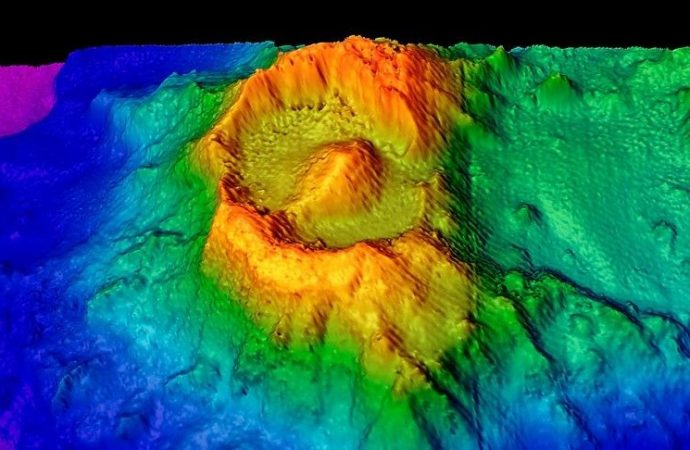It is one of several discoveries named after “The Lord of the Rings.”
Source: Live Science
Researchers exploring the Indian Ocean have discovered the remains of a collapsed underwater volcano with an uncanny resemblance to the all-seeing “Eye of Sauron” from J.R.R. Tolkien’s famous fantasy series “The Lord of the Rings,” as well as two other seafloor structures named after places in Tolkien’s Middle-earth.
The eye is actually an oval-shaped depression measuring 3.9 miles (6.2 kilometers) long by 3 miles (4.8 km) wide. Called a caldera, this giant divot is left over from the ancient collapse of a deep-sea volcano. The caldera is surrounded by a 984-foot-tall (300 meters) rim, giving the impression of eyelids, and an equally tall cone-shaped peak at the center, which looks like a pupil, according to The Conversation. The unusual structure is located 174 miles (280 km) southeast of Christmas Island ― an Australian external territory off mainland Australia ― at a depth of 10,170 feet (3,100 m).
A team of researchers discovered the structure while onboard the ocean research vessel Investigator, owned by Australia’s Commonwealth Scientific and Industrial Research Organisation (CSIRO), on the 12th day of an expedition to Australia’s Indian Ocean Territories. The researchers used multibeam sonar to create 3D maps of the caldera and the surrounding seafloor.
Like other calderas, this one formed when the peak of the original volcano collapsed, according to the researchers.
“The molten magma at the base of the volcano shifts upwards, leaving empty chambers [below],” chief scientist Tim O’Hara, senior curator at Museums Victoria in Australia, wrote in The Conversation. “The thin, solid crust on the surface of the dome then collapses, creating a large, crater-like structure.”
The area surrounding the volcanic crater is also home to two other noteworthy structures.
“Our volcanic ‘eye’ was not alone,” O’Hara wrote. “Further mapping to the south revealed a smaller sea mountain covered in numerous volcanic cones, and further still to the south was a larger, flat-topped seamount.”
Continuing the connection to Tolkien’s fantasy epic, the researchers named the cone-covered mountain Barad-dûr, after Sauron’s main stronghold, and the seamount Ered Lithui, after the Ash Mountains, both of which are found alongside the Eye of Sauron in the evil realm of Mordor.
The Ered Lithui seamount is part of a cluster of seamounts thought to date back about 100 million years, O’Hara wrote. The Ered Lithui seamount was once above the water’s surface, giving it its flat top, and it has gradually sunk to around 1.6 miles (2.6 km) below sea level.
Over millions of years, sand and sinking detritus — particulate matter, including plankton, excrement and other organic matter — have coated the seamount in a thick layer of sediment around 328 feet (100 m) deep. However, the caldera remains relatively uncovered, suggesting it may be significantly younger, O’Hara said.
“This sedimentation rate should have smothered and partially hidden the caldera,” O’Hara wrote. It also “looks surprisingly intact for a structure that should be 100 million years old.”
This freshness suggests that the volcano was created, and subsequently collapsed, after the seamount began sinking into the ocean.
“It is possible that volcanoes have continued to sprout long after the original foundation,” O’Hara wrote. “Our restless Earth is never still.”
Source: Live Science

































Leave a Comment
You must be logged in to post a comment.